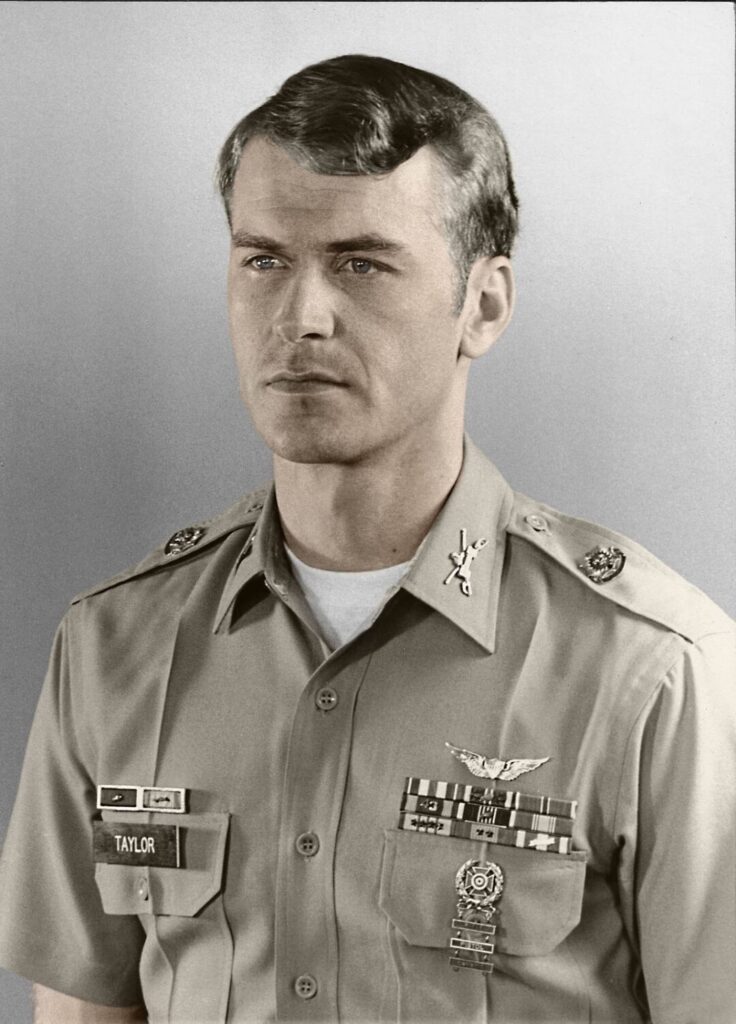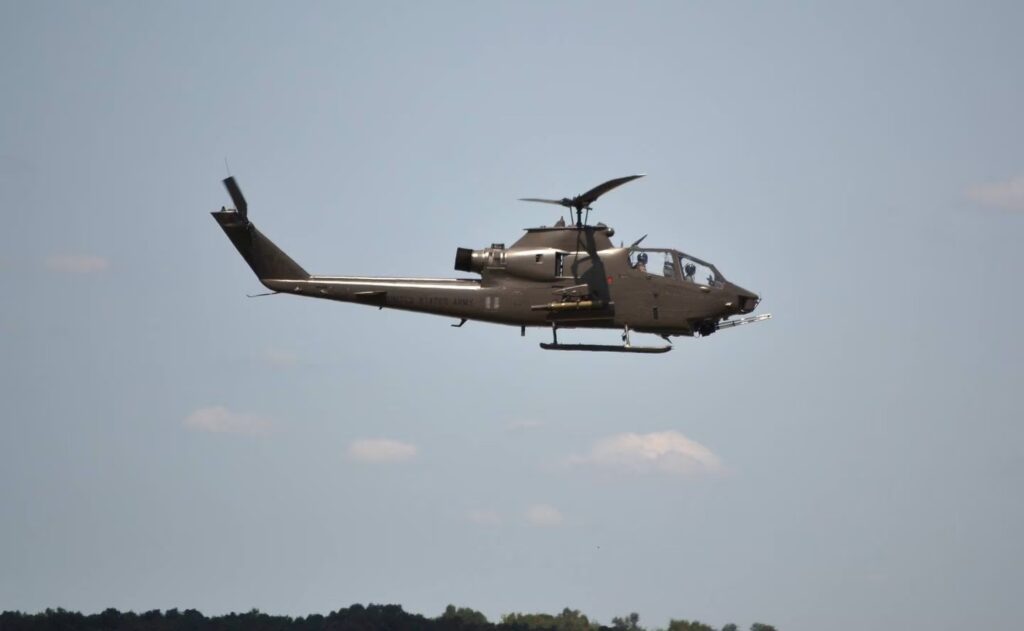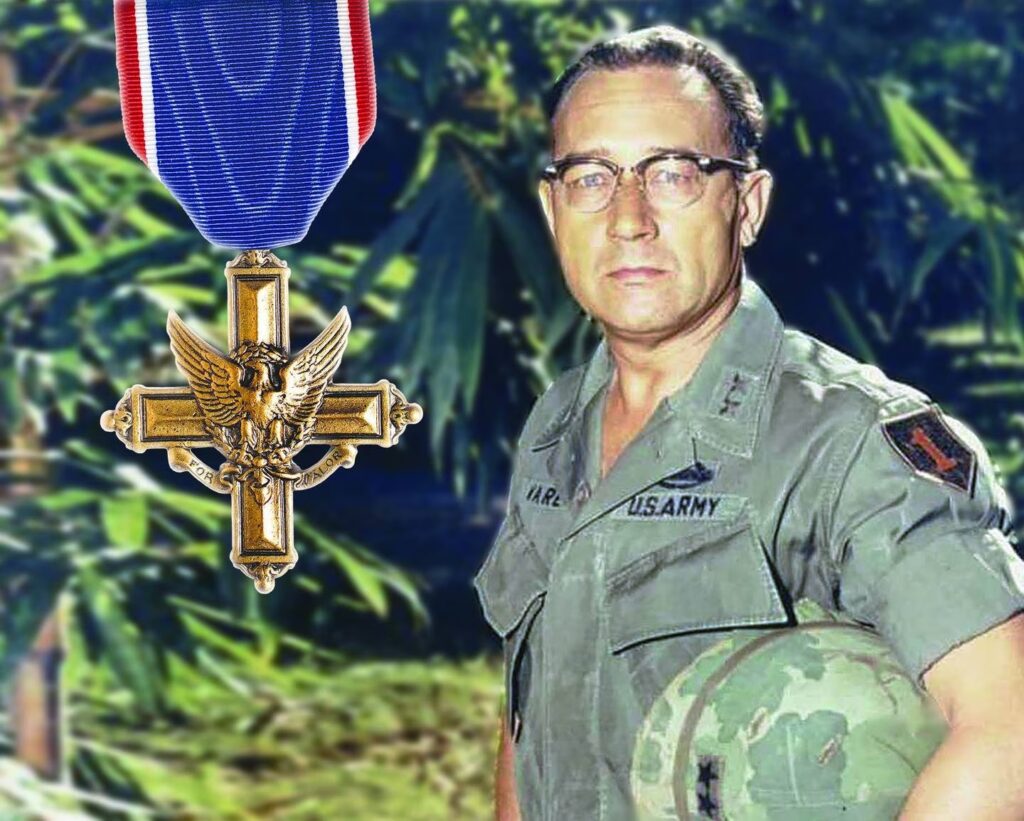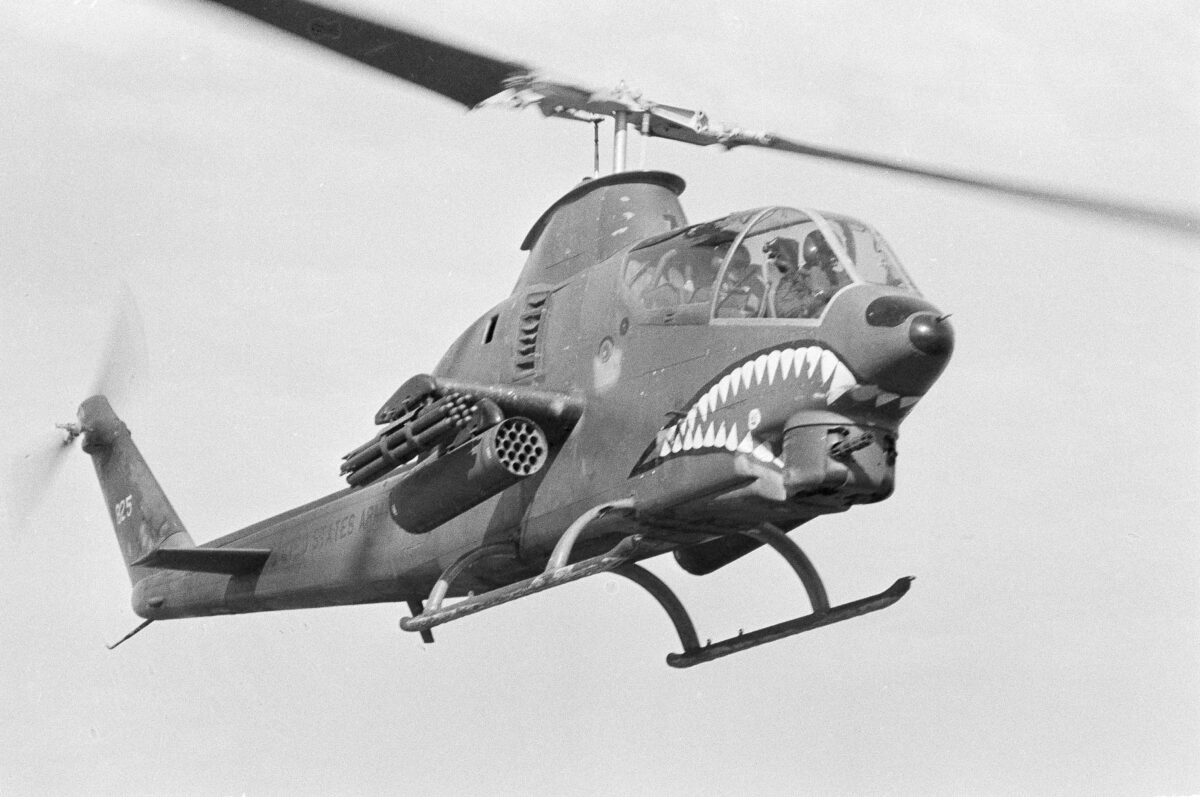Sgt. David Hill’s team leader gestured for him to get down. He and his two other teammates softly lowered themselves, careful not to make any noise.
Out on a standard reconnaissance mission, the four-soldier team had only moments ago reversed course after the team leader had used a Starlight scope to spot enemy soldiers blocking three sides around them in the pitch-black South Vietnam night.
Now with the fourth side blocked, the team squatted, boxed in and alone.
“We were in a Custer-like situation,” Hill said.
The closest terrain feature was the Saigon River, about a mile away. But across swaths of open rice paddies, a crossing would have meant a death sentence.
At least a few squads, possibly platoons, of enemy soldiers had likely set up multiple ambush points.
Luckily a water buffalo trail, hard-packed by the massive beasts, formed a kind of natural parapet for at least some cover.
They put claymore mines around their position, and the four men set up back-to-back, each covering an entire cardinal direction, waiting for the rush to come.
Team leader Pfc. Robert Elsner, from Manhattan, New York called for everything — artillery, air support, help. The team leader had been a sergeant about a week before, and was now a private, having gotten on the bad side of some commander or other, but would soon be a sergeant again. Rank aside, he was the best leader for the job.
At about 2100, on the northeast side of Saigon, about 30 miles away, the plea crackled over staticky radio.
The call was answered by 1st Lt. Larry L. Taylor, of Chattanooga, Tennessee, who alongside his co-pilot and gunner CWO2 J.O. Ratliff, of Cody, Wyoming jumped into a two-seat attack helicopter, the AH-1G Cobra, call sign “Dark Horse 32,” and took flight alongside Taylor’s wingman, Capt. Roger D. Trickler, 31, of Daleville, Alabama, and his co-pilot and gunner, Capt. Richard Driggs LeMay Jr., 27, of New Britain, Connecticut.
The four aviators were part of Troop D (Air), 1st Squadron, 4th Cavalry, 1st Infantry Division. The men on the ground were out of “Wildcat 2″ the call sign for their four-soldier recon team under F Company, 52nd Infantry (Long Range Patrol) 1st Infantry Division.
The next half hour would witness one of the most daring rescues of the Vietnam War, and it would be carried out by a helicopter designed only for attack. In the weeks following, death after death hit the unit. Those who knew just what Taylor had done either spread out on other combat missions or died in tragic, but all too common events for that time in the war.
In those ensuing decades the men from that night would grow gray, reunite and Hill, among others, would fight a different battle, one with folders, yellowing documents and binder clips instead of M16s, grenade launchers and claymores.
But on both the fateful night of June 18, 1968, and now in the coming days, their tenacity, perseverance and intrepidity would prove victorious.
And that’s the start of how former Capt. Larry L. Taylor will become, on Sept. 5, the most recent recipient of the nation’s highest valor award: the Medal of Honor.

Beginnings
Taylor, 81, grew up in the historic St. Elmo neighborhood of Chattanooga.
That area rests in the shadow of Lookout Mountain, where in November 1863, Union troops flowed up the northern slopes in what historians would later call the “Battle Above the Clouds.” This followed a northern victory at the battle of Chickamauga, Georgia and what led to the Union siege of Chattanooga, part of a later-war development to control rail lines and break the infrastructure supporting the Confederacy.
This served not as a history class lesson, but a direct connection for Taylor, whose great-great-grandfather fought in the Civil War. The family later sent his great-uncle to fight in World War I and both his father and uncles fought in World War II.
Taylor joined the U.S. Army Reserve Officer Training program at the University of Tennessee just up the road from Knoxville, Tennessee shortly after high school, graduating in 1966.
The Army sent the Tennessee boy to Fort Knox, Kentucky for armor training. But as soon as he could, the young Taylor found his way into the fledgling Army aviation helicopter branch. By June 1967 he was an Army aviator.
Taylor’s explained in multiple interviews why he decided to fly instead of stay in the armor branch, where the Army first put him.
He painted a stark picture of the life of ground troops in Vietnam in his soupy Tennessee drawl.“I had been on the ground in Vietnam and it sucked, so I wanted to avoid all of that,” Taylor said.
It was a place where someone might wait behind every tree to shoot you all day while they mortared your position all night. But in a Cobra, you can fly above that at 150 mph carrying 76 rockets and 16,000 rounds of machine gun ammo.
“So yeah, I’d rather be an ass kicker than have my ass kicked,” Taylor said. “That settles that question.”
At around the time Taylor was earning his wings, the Army was refining how it would fight in places such as Vietnam. Early work with the UH-1 Iroquois helicopter proved that an attack helicopter could provide support for larger transport helicopters, much like fighter planes and bombers paired together in World War II.

But the Iroquois wasn’t purpose-built for that mission. So, the service worked with Bell Helicopter and adapted the Iroquois system into a newer, nimbler attack helicopter eventually dubbed the AH-1 Cobra.
The first prototype flew in September 1965, while Taylor still rooted for the Tennessee Volunteers at football games in Knoxville.But by June 1967, when Taylor became an aviator, the Cobra was in the Army inventory and batches were being delivered to Vietnam. The same place Taylor found himself by August 1967.
The young lieutenant flew some of the first combat missions with the AH-1G Cobra. Eventually, he’d fly as many as 2,000 missions in both the Iroquois and Cobra. About 1,200 were combat missions. Taylor estimated that at least 1,000 of those combat flights involved supporting the long-range reconnaissance patrols. In 340 of those missions, he took enemy fire and was forced down five times, according to information provided by the Army.
By June 18, 1968, the war, which would continue for another seven years, was not going well. U.S. and South Vietnamese forces had turned back the Tet Offensive earlier that year, but, as many historians now note, those events piled on an already dismal view of the war and paltry public support back home.
In May 1968, then-President Lyndon B. Johnson and North Vietnamese leaders began peace talks. Johnson had already announced he would not seek reelection. That year alone nearly 17,000 U.S. troops would die in Vietnam.
But soldiers such as Taylor and Hill still had tours to complete and missions to accomplish.
Dark as an inkwell
When Taylor and his co-pilot approached Hill and his team’s position south of Saigon, not a single light illuminated where they were. Taylor had to use radio direction-finding to somewhat gauge where the four-soldier team had hidden.
The team leader whispered on the radio microphone to avoid letting enemy troops know exactly where they lay.
“It was dark, there was nothing down there with a light on and I didn’t think I was ever gonna find them,” Taylor said in a recent phone interview.
Taylor radioed the team and said that he didn’t want to start launching rockets without knowing their position. He told them that once he was directly over them they should say “now” in the radio and he would then fly on, circle back and come get them.
The tactical operations center tried to wave Taylor off. They said the team was trained to escape and evade. They could handle themselves.
“I told them there’s no place for them to escape and evade to,” Taylor said. “Please stay off my radio.”
The chopper flew past, someone yelled over the rotor wash into the radio, “you’re over us now.”
Taylor told them to mark their position with flares, red star clusters popped in the night sky and what seemed like a wall of bullets began flying from both sides on the ground.He knew where the team sat, he began firing rockets and ripping through 7.62mm ammunition from the Cobra’s mini-gun.
Elsner fired his 5.56mm carbine, a shortened version of the standard issue M16.
Hill opened up with his Korea-era, .30 caliber M1 carbine which he’d sawed down the barrel for easier carry. The rear security man chose it because the .30 caliber rounds sounded like what their counterparts fired. If the team, which had been running patrols together since February, needed an indistinguishable, single-shot kill, they called up Hill with his M1.Grenadier Spc. 4 William P. Cohn, or Billy, of Old Mystic, Connecticut, lugged the M79 grenade launcher, a specially made 18-round high explosive grenade carrier vest and a backup .45 caliber 1911 handgun.
Radio operator Cpl. Gerald Patty, of Marysville, Tennessee, fired off from his CAR-15.Every team member carried an additional five extra 40mm grenades for Cohn’s M79.
Each soldier had stepped off on that foot patrol with 650 rounds. The grenadier alone fired 75 grenades from his M79 launcher in the handful of minutes they’d repelled the onslaught from an unknown number of enemy troops in the night.
Within moments Taylor was out of rockets and machine gun ammo. The four-soldier team had fired all their ammunition and had only a satchel full of fragmentation grenades and the trusty claymore antipersonnel mines. And their knives.
“We were all tapped out, we had nothing left,” Hill said.
Taylor was out of ammo too, but not out of bluffs.
He told the ground team to reposition their claymores to the northeast and southeast. When they saw him begin his next run at the enemy, Taylor figured they’d think he would fire on them, distracting the enemy troops just enough.
“We’re gonna blow a hole in that ring,” Taylor said.
The lieutenant told the team to fire those claymores and then “run like hell” on a 135-degree azimuth, the opposite direction. “I’ll be there, and I hope so are you.”
Hill still had about a dozen grenades in his rucksack. He took rear security as the men skedaddled, lobbing a grenade every few seconds into inkwell night.
A new mission
Three decades later Hill and Taylor met at a unit reunion. The pair shared memories of that night and other escapades from before and after as the two had finished their tours a lifetime ago. A few of their comrades hadn’t made it out of Vietnam alive. Others had or would succumb to the indignity of a car wreck, cancer and other quiet calamities.
It was at that 1999 reunion in Branson, Missouri when Hill learned that Taylor had received the third highest valor award available, the Silver Star Medal. But Hill knew how much that night meant, how daring, bold and, maybe a little crazy, things had been, and he knew what Taylor had done. This was something that never happened before and probably never will again. Others had received more prestigious awards for less.
A few years later Hill retired from a career with the U.S. Department of Commerce. He moved from California to Nevada. He kept busy managing a golf course but had an itch.
The Silver Star Medal? It wasn’t enough.
The former sergeant began a kind of bureaucratic trek to revisit the heroism of that fateful evening that saved his life.
He gathered documents, talked with politicians, researched websites and submitted a packet asking the Army to review the case. Hill hit hurdles and roadblocks that have stymied others for decades. The Army and most military branches are reluctant to second-guess the decisions of the commanders on the ground who recommend or approve valor award citations.
Part of the criteria involves evaluating whether what’s being submitted in a review request was available to commanders at the time. Basically, did they have all the information, did the commanders know all of what happened?
After a few failed attempts, Hill met with retired Army Gen. B.B. Bell, a 39-year Army veteran who retired in 2008 after having led the United Nations Command in South Korea.
By The Numbers:
- 3,535 Medals of Honor awarded
- 268 for Vietnam
- 65 living Medal of Honor recipients
- 54 total Army aviators have received the Medal of Honor
- 12 Army aviators received the Medal of Honor for service in Vietnam
Source: The Army Aviation Museum; Congressional Medal of Honor Society
Bell retired to Signal Mountain, Tennessee where Taylor has lived now for decades.
The general asked questions that Hill hadn’t yet considered — were any of the members of his four-soldier recon team interviewed following the June 18, 1968, rescue?
No.
The pair found the former Army officer who’d overseen awards and decorations for Taylor’s unit in Vietnam. No, the officer confirmed they’d not interviewed the ground team.
Combat continued after that June night, getting witness statements and commanding officer approvals wasn’t high on the priority list for a division engulfed in daily combat. But without that paperwork and those command approvals, only so much could be done.
Also complicating the decision process, nearly three weeks after the June mission on July 4, 1968, Taylor’s commanding officer, Maj. Federick Terry, 31, died in a midair collision while responding to a call for help when a U.S. armored vehicle struck a landmine on a movement, injuring several soldiers.
Tragedy struck the unit again a few weeks later. On Sept. 12, 1968, LeMay, the co-pilot in the second helicopter on the June mission, died along with 1st Lt. William Henry Hanson, 31, Park Falls, Wisconsin, in a Cobra gunship crash while defending ground troops east of Quan Loi in Binh Long Province.
The next day, the division commander over Taylor’s unit, Maj. Gen. Keith Lincoln Ware, who had received the Medal of Honor for his own actions in World War II, died in a helicopter crash near Cambodia.

Armed with these new facts, Hill resubmitted his review request in 2021, for the third time.
Back on the battlefield that fateful night…
Empty on ammo, out of grenades and enveloped in a cacophony of explosions, rifle and machine gun fire, Hill and his team ran into a clearing as Taylor stomped on the left pedal and plopped his Cobra on the ground.
As they descended, Taylor’s co-pilot asked, “what are we going to do with them?”“I said, ‘I don’t know, I didn’t think that far ahead,’” Taylor said.
The Cobra has no seating for passengers. It is a narrow fuselage aircraft with seats for a pilot and co-pilot, stacked atop each other. Its stubby wings and light frame hold weaponry — a minigun and rocket launchers — and two slender skids come between the aircraft and the ground.
“I didn’t have to tell them to get on,” Taylor said.
On June 18, 1968, Hill and Cohn straddled the rocket launchers like horses while Elsner and Patty hugged the skids.
“Which is exciting in the dark,” Hill said.
They banged hard twice on the frame, that was technical military code for “haul ass.”
Once airborne, Taylor knew that they couldn’t fly these guys at 150 miles an hour back over Saigon and to Phu Loi Base where he was headquartered.
At higher altitudes and speeds, the men would freeze and fall off the aircraft. So, he stayed as low as incoming fire would allow and dropped the quad at a nearby water plant where they radioed ahead so the team could link up with a friendly unit.
Hill remembers a glimpse of a vague profile outline of a helmeted Taylor through the plastic windshield.They landed, the four men ran to the front of the aircraft so Taylor and his co-pilot could see them. The four saluted the men who’d saved their lives and then they were gone.The memory halts Taylor’s speech, sticking in his throat when he tells the story, even a lifetime later.
Recognition
On an early June morning, Taylor awakened to his ringing phone.
President Joe Biden told the old soldier that he’d “read his file.”
The two talked for about 15 minutes, Taylor told local media outlets. He remembers telling the commander-in-chief, “I just did my job.”
That’s how, 55 years later, Taylor learned he would join an exclusive group, honoring the highest standards of combat valor in the U.S. military.
While the recognition is nice, bringing that team home alive proved the enduring reward for not only that half-hour mission but for the 2,000 or more missions he flew those many years ago so far from home.
“We never lost a man,” Taylor said. “We lost some aircraft, but we never lost a man.”
*This article drew information from the following sources: local media reports including the Chattanooga (Tenn.) Times Free Press; the Chattanoogan; Cody (Wyo.) Enterprise; video published online of Gen. B.B. Bell speaking at The Walden Club; a media roundtable phone interview with Larry Taylor, David Hill and James Holden; A separate phone interview with David Hill; the Vietnam Veterans Memorial Fund database; the Army Office of the Chief of Public Affairs; whitehouse.gov; U.S. State Department; U.S. Department of Defense; honorstates.org; Google Earth; Freedom Sings Publishing; Pritzker Military Museum and Library; Vietnam Helicopter Pilots Association.
Originally published by Military Times, our sister publication.





